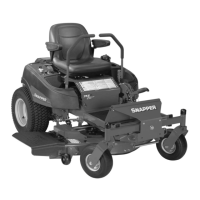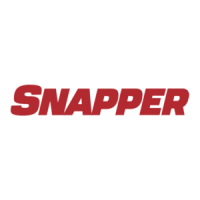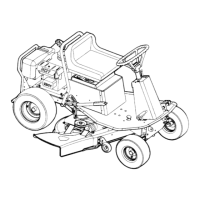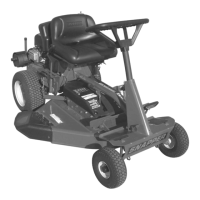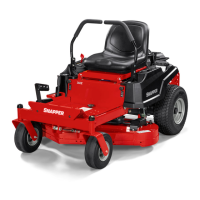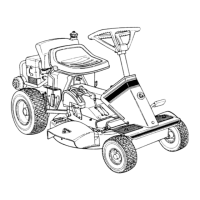Important OperatorSafety Instructions(Continued)
Readthese safety rulesand follow them closely. Failureto obey these rules could result in loss of control of unit,
severepersonal injury or deathto you, or bystanders,or damageto property or equipment.
Thismowinqdeckis capableof amputatinqhandsandfeet andthrowinqobjects. Thetriangle _ in text signifies
important cautions or warnings which must befollowed.
GENERALOPERATION
1. Read,understand,and follow all instructions in the
manualand on the unit beforestarting.
2. Donot put handsor feet near rotating parts or under the
machine. Keepclear of the dischargeopening at all
times.
3. Onlyallow responsible adults,who arefamiliar with the
instructions, to operatethe unit (local regulations can
restrict operatorage).
4. Clearthearea of objects such as rocks, toys, wire, etc.,
which could be picked up andthrown by the blade(s).
5. Besurethe area is clearof other peoplebefore mowing.
Stopthe unit if anyoneentersthe area.
6. Nevercarry passengers.
7. Donot mow in reverse unlessabsolutely necessary.
Always look down and behind before and whiletravelling
in reverse.
8. Neverdirect discharge materialtoward anyone. Avoid
discharging material against a wall or obstruction.
Materia/may ricochetback toward the operator. Stopthe
blade(s)when crossing gravelsurfaces.
9. Donot operatethe machine without the entire grass
catcher, dischargeguard (deflector), or othersafety
devicesin placeand operational.
10. Slow down beforeturning.
11. Neverleavea running unit unattended.Always disengage
the blades (PTO),set parking brake,stop engine,and
remove keysbeforedismounting.
12. Disengageblades(PTO)when not mowing. Shut off
engine and wait for all parts to come to a complete stop
beforecleaningthe machine, removing the grass catcher,
or uncloggingthe discharge guard.
13. Operatethe machineonly in daylight or good artificial
light.
14. Donot operatethe unit while underthe influence of
alcohol or drugs.
15 Watch for traffic whenoperating near or crossing
roadways.
16. Useextra carewhen loading or unloading the unit into a
trailer or truck.
17. Always weareyeprotection when operatingthis unit.
18. Dataindicatesthat operators,age 60 years and above,
are involved in a large percentageof power equipment-
relatedinjuries. Theseoperators should evaluatetheir
ability to operatethe equipment safelyenough to protect
themselvesand others from injury.
19. Followthe manufacturer's recommendationsfor wheel
weights or counterweights.
20. Keepin mind the operatoris responsiblefor accidents
occurring to other people or property.
21. All drivers should seekand obtain professionaland
practicalinstruction.
22. Always wearsubstantial footwear and trousers. Never
operatewhen barefoot or wearingsandals.
23. Beforeusing, alwaysvisually checkthat the bladesand
bladehardwareare present,intact, and secure. Replace
worn or damagedparts.
24. Disengageattachments before: refueling, removing an
attachment, makingadjustments (unlessthe adjustment
can be madefrom the operator's position).
25. Whenthe machineis parked,stored, or left unattended,
lowerthe cutting meansunlessa positive mechanical
lock is used.
26. Beforeleavingthe operator's position for any reason,
engagethe parking brake(if equipped),disengagethe
blades(PTO),stop the engine,andremove the key.
27. To reducefire hazard,keepthe unit freeof grass,leaves,
& excess oil. Do not stop or park over dry leaves,grass,
or combustible materials.
28. It isa violation of California Public ResourceCode
Section4442 to use or operatethe engine on or nearany
forest-covered, brush-covered, or grass-covered land
unlessthe exhaustsystem is equippedwith a spark
arrester meeting anyapplicablelocal or state laws. Other
states or federalareasmay havesimilar laws.
29. OSHAregulations may require the use of hearing
protection whenexposedto sound levelsgreaterthan 85
dBAfor an 8 hour time period.
A CAUTION
O his machineproducessoundlevels in
excessof85 dBAat the operator'sear and
cancausehearinglossthroughextended
periodsofexposure.
Wear hearingprotectionwhen operatingthis
machine.
TRANSPORTING AND STORAGE
1. Whentransporting the unit on an open trailer, makesure
it is facing forward, in the direction oftravel. If the unit
is facing backwards,wind lift could damagethe unit.
2. Always observesafe refuelingand fuel handling practices
when refuelingthe unit after transportation or storage.
3. Neverstore the unit (with fuel) in an enclosedpoorly
ventilated structure. Fuelvapors can travelto an ignition
source (such asa furnace, water heater,etc.) and cause
an explosion. Fuelvapor is alsotoxic to humans and
animals.
4. Always follow the engine manualinstructions for
storage preparationsbefore storing the unit for both
short and long term periods.
5. Always follow the engine manualinstructions for proper
start-up procedures when returning the unit to service.
6. Neverstore the unit or fuel container inside wherethere
isan openflame or pilot light, such asin a water heater.
Allow unit to cool beforestoring.
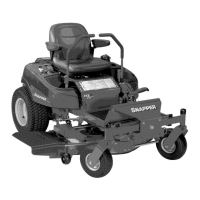
